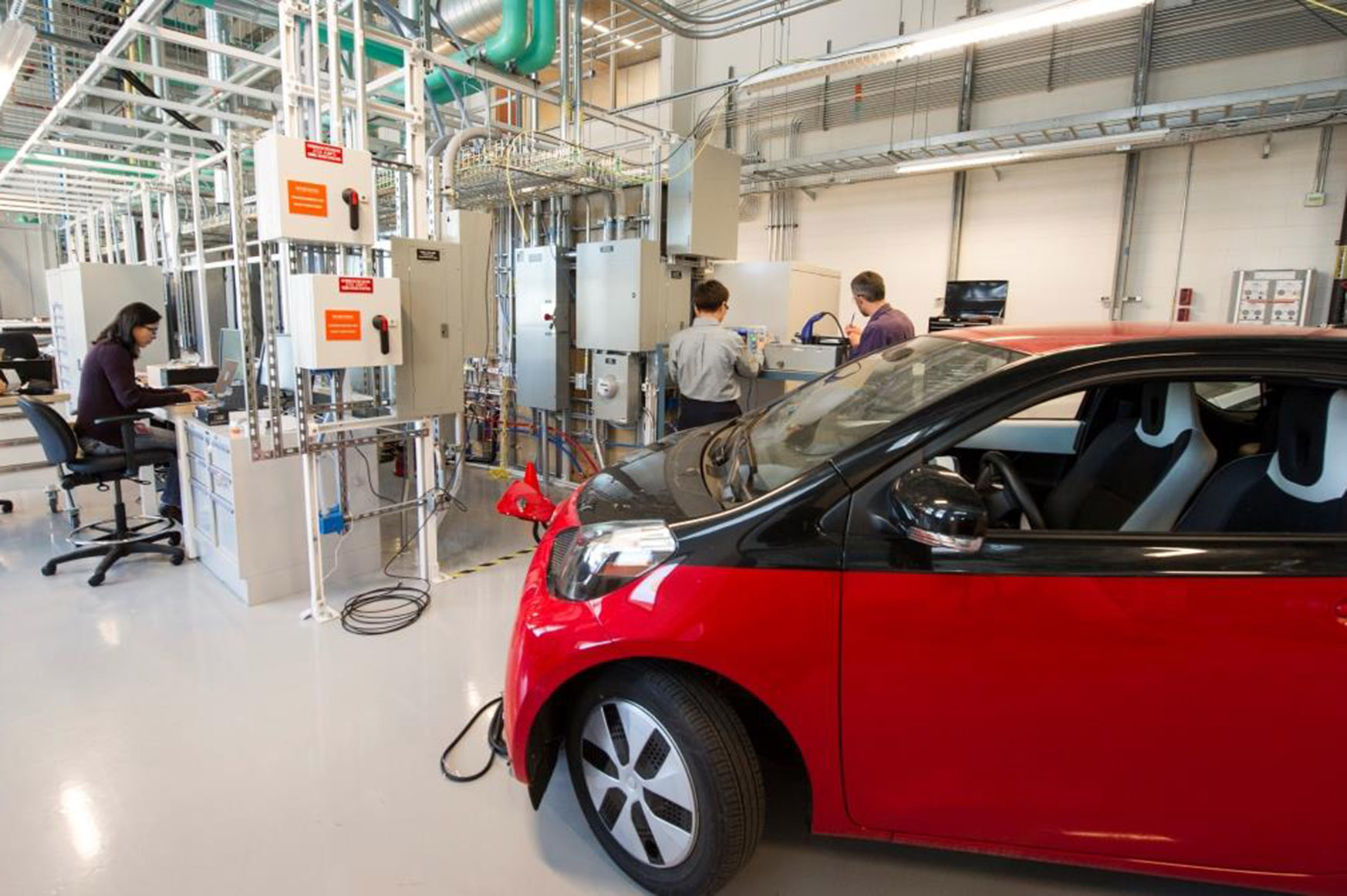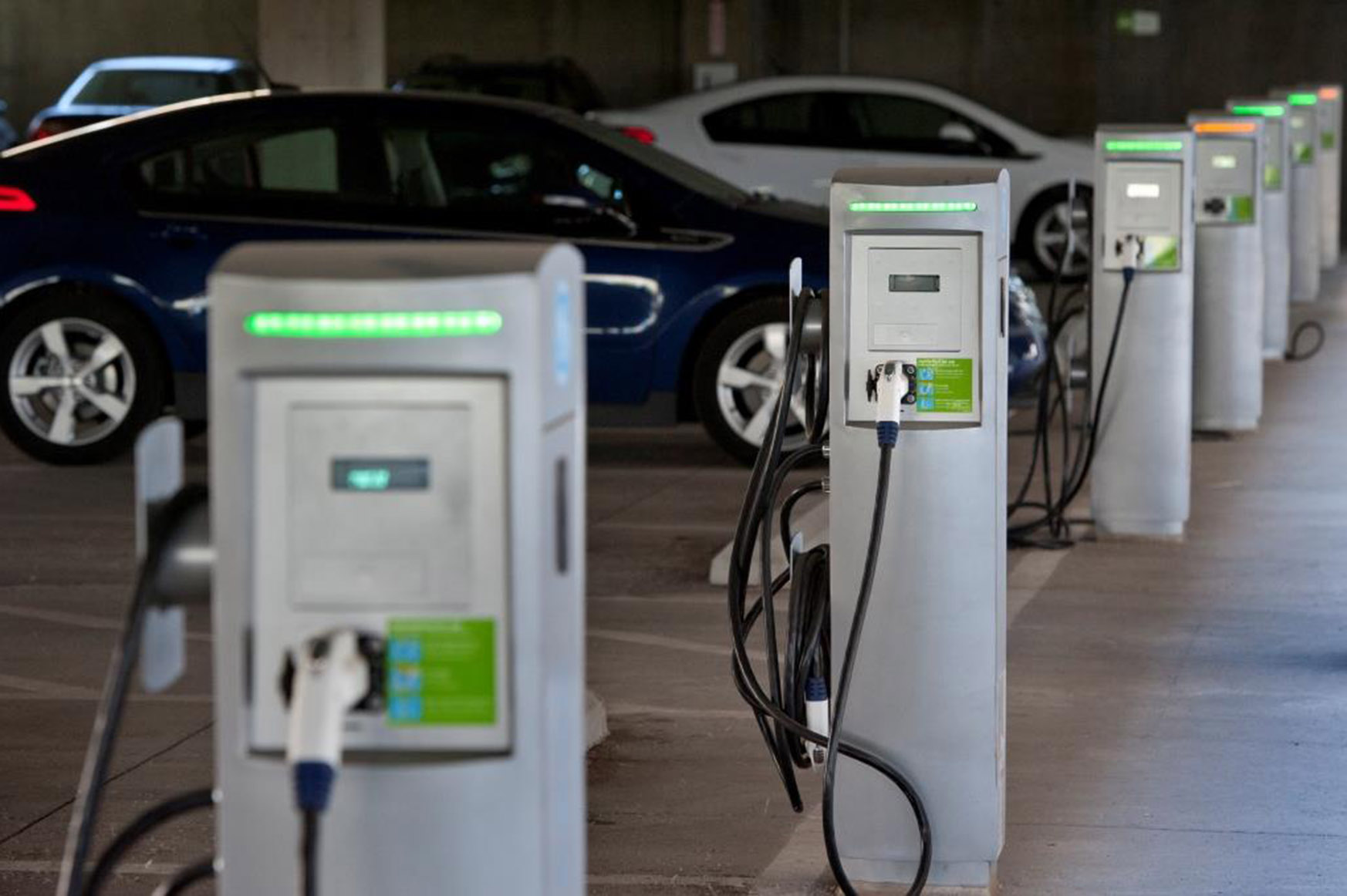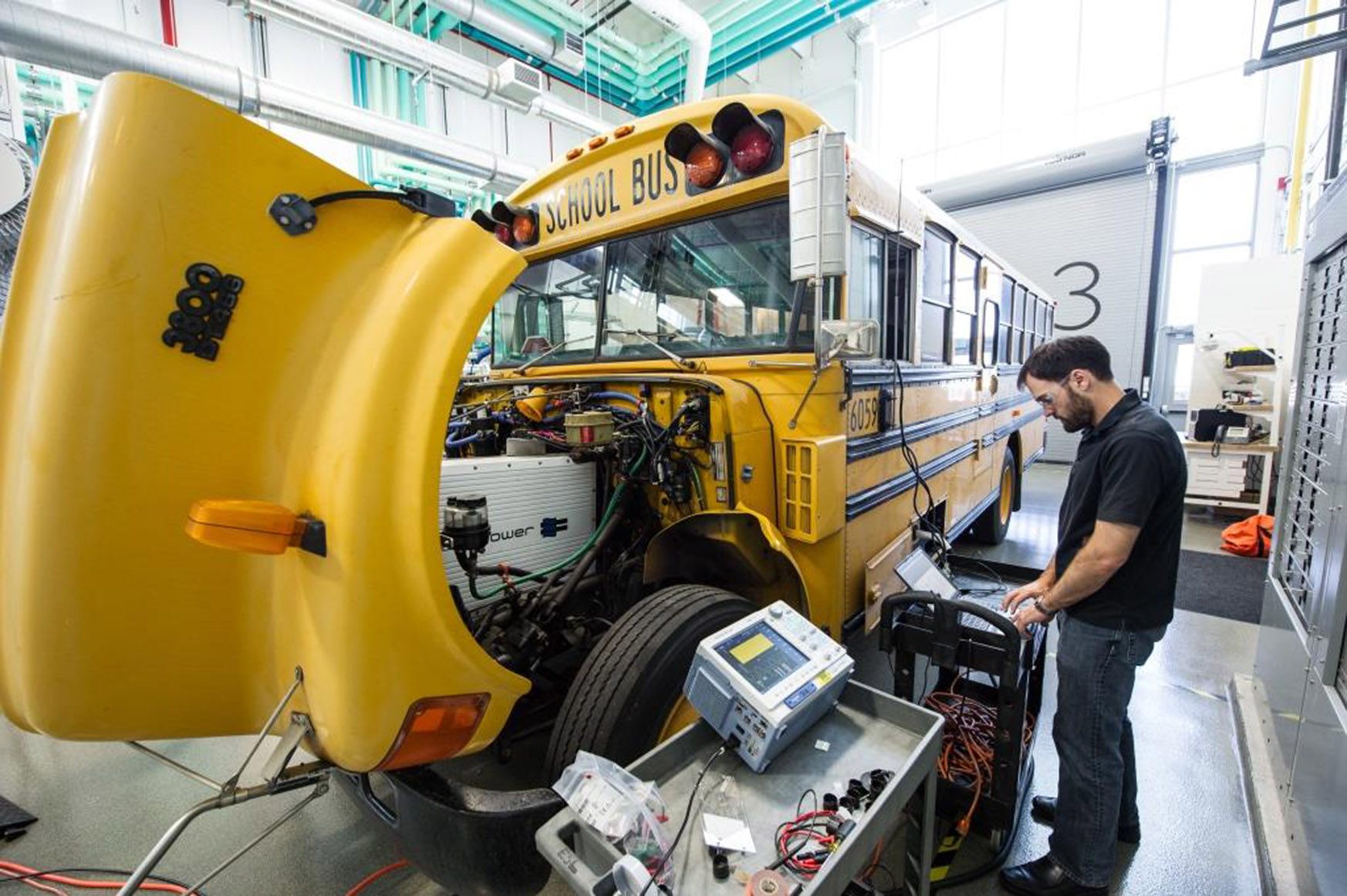Connecting Electric Vehicles to the Grid for Greater Infrastructure Resilience

NREL engineers study the dynamics of how EVs interact with the grid at the Energy Systems Integration Facility. Photo by Dennis Schroeder, NREL
As the market for electric vehicles (EVs)—including fully electric vehicles and plug-in hybrid electric vehicles—and the demand on the U.S. electric grid continue to grow, EVs have the potential to help balance loads and improve the resiliency of our nation's electricity infrastructure. Vehicle-to-grid (V2G) technology makes it possible to store surplus electricity generated from intermittent renewable solar and wind sources in EV batteries during non-peak periods and feed power back to the grid when needed, enhancing grid stability and reducing electricity costs at peak hours.
The U.S. Department of Energy's (DOE's) National Renewable Energy Laboratory (NREL) has managed a variety of studies and partnerships under the Integrated Network Testbed for Energy Grid Research and Technology Experimentation (INTEGRATE) project, which aims to enable the nation's electric grid to handle increasing amounts of renewable energy. Part of DOE's Grid Modernization Initiative, INTEGRATE was designed to allow renewable energy systems and other energy technologies to be connected to a smart grid in a "plug-and-play" manner, similar to how computers automatically connect to new devices plugged in by users.
As part of the broad-reaching INTEGRATE project, NREL's transportation team played a leadership role in INTEGRATE's transportation-related efforts, collaborating with industry partners and other national labs across the country. Building on INTEGRATE's achievements, work continues today under the Grid Modernization Laboratory Consortium.
"Although we had already made significant strides in vehicle-to-grid and vehicle-to-building integration, INTEGRATE breakthroughs in the past few years have allowed us to take this research to the next level—finding new models for energy efficiency that bridge transportation, building, and infrastructure solutions," said Chris Gearhart, director of NREL's Transportation and Hydrogen Systems Center.
Transportation research has examined the technical requirements for widespread V2G integration, automated EV charging options, and potential related economic and grid performance impacts.
The intelligent integration of vehicles, the electric grid, renewable energy sources, buildings, and transportation infrastructure is crucial to moving energy savings and connectivity to the next level. The Energy Systems Integration Facility at NREL is the nation's premier facility for this cutting-edge research. This world-class facility is used in tandem with the lab's Vehicle Testing and Integration Facility and EV charging station installation to explore system-scale interactions and develop real-world solutions designed to meet end-user needs. Combined with the Peregrine high-performance computer, which affords unprecedented modeling and simulation of fully integrated systems, these facilities have allowed researchers to evaluate the performance of vehicle and infrastructure equipment with simulated grid conditions on a large scale.
The NREL campus acts as a living lab, with projects taking place in state-of-the-art research facilities and real-world settings, including NREL's parking garage. Home to 36 EV charging stations and a 1.2-MW photovoltaic array, the garage serves as a test bed for assessing various EV charging scenarios. Charging employee-owned and demonstration vehicles is intelligently controlled via NREL-developed software that integrates driver needs with campus-level forecasts and load data to activate and deactivate individual charging stations. Based on EV driver input data, the software estimates the amount of energy needed by the vehicle before departure time and adjusts the charging schedule based on real-time campus data to better utilize NREL's solar energy generation.

The EV charging station installation at NREL's parking garage serves as a test bed for assessing various EV charging scenarios. Photo by Dennis Schroeder, NREL
Bidirectional EVs and New Charge Management Systems Crucial to V2G Success
Most EVs today are unidirectional, meaning that they can only import electricity by charging the battery. Similarly, most EV charging stations are designed for unidirectional operation—they export electricity to the vehicle. Bidirectional, also known as V2G-capable, EVs can feed electricity from their batteries to the grid via bidirectional charging stations and are expected to become more common with increased market demand and infrastructure. An NREL partnership with the University of Delaware focused on evaluating the ability of bidirectional EVs to export electricity and increase the capacity of the grid.
"Using EVs to send power back to the grid can help utilities when renewable energy isn't available," Gearhart said. "Bidirectional charging gives EVs the potential to balance variable production from intermittent renewable sources, supply emergency backup power, and act as grid-tied energy storage devices."
The INTEGRATE team explored the V2G characteristics of a BMW Mini E, a TransPower school bus, and three charging stations. Related R&D involved evaluating a state-of-charge management system and aggregator technology developed through open-source protocols by the University of Delaware. The protocols are used to track and manage the exchange between the vehicles and charging stations in a way that enables the use of renewable power and allows the vehicles to participate in grid services.
"This open-source effort aims to remove barriers to the commercial entry of V2G technologies and to improve the potential for vehicles to earn revenue from their participation in grid services," said Andrew Meintz, NREL research engineer.

An NREL engineer analyzes the hardware and controls associated with the V2G functionality of an electric school bus at the Energy Systems Integration Facility. The vehicle's V2G integration capabilities enable it to feed power back to the grid and essentially serve as a mobile power generator. Photo by Dennis Schroeder, NREL
Multi-Lab Collaboration Examines Opportunities to Integrate EVs with the Smart Grid
The perception of EVs has evolved from that of energy-efficient and pollution-reducing transportation options to integral components in a diversified, smart, integrated energy system that incorporates traditional and renewable energy sources. In collaboration with Argonne National Laboratory, Idaho National Laboratory, Lawrence Berkeley National Laboratory, Pacific Northwest National Laboratory, and Oak Ridge National Laboratory, the NREL-led INTEGRATE team defined various EV grid integration scenarios, the opportunities they present, and the associated system implementation requirements.
The results of the multi-lab EV grid integration study provided DOE with input critical to the future direction of R&D activities, with a focus on overcoming grid demand and EV adoption challenges and boosting overall system efficiency.
Utilities are beginning to recognize EVs' potential for low-cost, highly controllable, and rapidly responding energy storage, as well as an opportunity for increased electricity sales. At the same time, the possible negative impact of a high volume of unmanaged EV charging presents a sobering counterpoint to the opportunities these vehicles present for electricity grid storage.
"EVs have the potential to provide a low-cost form of grid storage, but this dual purpose can only prove feasible if their primary transportation role is preserved and charging activities are carefully managed," Meintz said.
The study identified three key research areas to address these barriers and open the door to increased value for V2G integration—grid-interactive vehicle system simulation tools, hardware component development and testing, and market structure evolution and utility engagement.
Simulation Quantifies Potential Savings Managed Charging Offers to Utilities
Managed charging can improve grid flexibility by more effectively utilizing renewable energy, shaving peak electricity demand, and filling demand valleys while still meeting the needs of EV drivers. Grid-integrated smart charging technology can deliver these benefits while averting creation of a second peak in electricity demand. Notably, this would result in lower electricity costs for all consumers, not just those who drive EVs.
As part of INTEGRATE's efforts to quantify the potential savings that managed charging offers to utilities, NREL researchers conducted a simulation in which a utility generates half its electricity from renewables. Simulation results, based on three million EVs implementing 50% optimized charging, indicate substantial annual benefits:
- Generate $310 million in grid savings
- Reduce electricity costs by 1%–3%
- Reduce peak demand by 1.5%
- Reduce grid-related carbon dioxide emissions by 1%–4%
- Reduce renewable curtailment by 25%.
Curtailment occurs when renewable energy from variable resources like solar and wind is available but cannot be absorbed into the electric utility system due to operational limitations. Essentially, curtailment represents lost opportunity to use zero-marginal-cost energy.
"Our simulation results suggest substantial grid operational cost savings as well as a drastic reduction in renewable curtailment associated with managing charging," Meintz said. "Key to achieving these savings is aligning EV energy demands with mid-day solar energy generation, which in turn requires increased opportunities for EV charging at workplaces and other mid-day parking locations."
Ongoing research is taking a closer look at ways to reduce the cost and extend the life of EV charging equipment, as well as strategies for increasing workplace charging opportunities across the nation.
Smart Charging Cuts EV Owners' Electricity Costs
Cost savings are at least as important to drivers as they are to utilities. Owners looking to make EV charging more affordable must understand that how, when, and where they plug in their cars influences their charging costs.
As part of a market opportunities study, NREL researchers explored multiple options for EV owners to minimize charging costs based on a range of market mechanisms and electricity rate structures, which are highly variable across regions. Timing proved to be the dominant factor in determining charging expenses. Demand-based rates, available mainly to large commercial customers, can provide low-cost energy for EV charging if appropriately timed. For residential consumers, taking advantage of time-of-use (TOU) electricity rates offers the primary option for controlling costs.
A charge management study quantified the potential savings that EV owners could achieve via managed charging based on TOU rate structures that encourage customers to conserve energy during peak times. TOU rates can also incentivize consumers to take advantage of low-cost electricity during periods of excess renewable energy generation. Such strategies provide the added benefit of helping keep electric costs down by reducing the need for utilities to invest in additional generation capacity.
The study examined the impact of three charging options:
- Opportunity charging – vehicle charging begins immediately
- Delayed charging – timing of charging delayed according to TOU rates and driver's schedule
- Smart charging with intelligent state-of-charge management – same as delayed charging, except the amount of charged energy is adjusted based on the presumed energy requirements of future trips.
Delayed charging and smart charging both selectively charge a vehicle at low TOU rates to minimize charge costs, while maximizing the use of renewable energy and driver convenience. The electricity price for opportunity charging is at least 11% higher than the annual average electricity price, while delayed charging effectively reduces the relative electricity price to 85%–93% of the average. Best of all, smart charging can reduce the electricity price to 75% of the average.
These are just a handful of the INTEGRATE and V2G projects NREL researchers have tackled. Other activities involve investigating wireless power transfer technologies and the reuse of EV batteries for stationary utility energy storage, as well as the potential for fuel cell vehicles in V2G applications.
Learn more about NREL's V2G work, the Grid Modernization Initiative, and the Grid Modernization Laboratory Consortium.
Learn more about NREL’s sustainable transportation research.
Last Updated May 28, 2025
